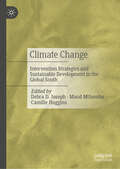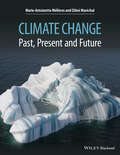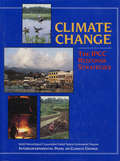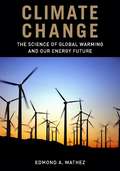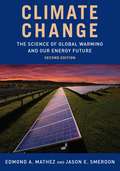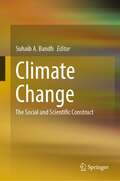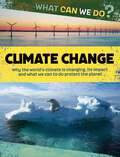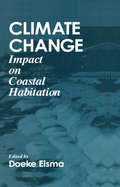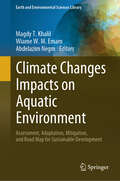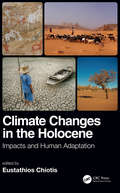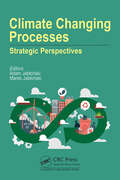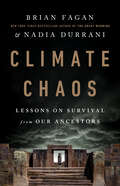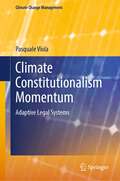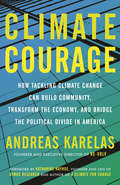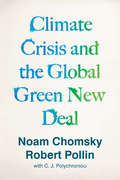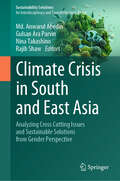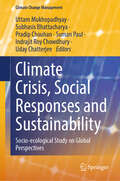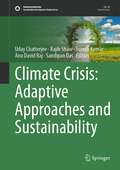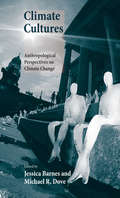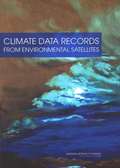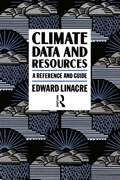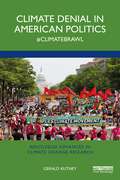- Table View
- List View
Climate Change: Intervention Strategies and Sustainable Development in the Global South
by Camille Huggins Debra D. Joseph Maud MthembuThis book highlights the challenges with respect to climate change in the Global South. It demonstrates what has been happening in varying countries in this geographic location and how sustainable adaptation interventions could be used to alleviate these challenges. Most countries in the Global South are extremely vulnerable and unprepared for the present and future impact of climate change. Some climate change events that are presently plaguing these locations are extreme weather events such as flooding, food insecurity, disasters and droughts. The book provides case studies and interventions that can be a source to others who are seeking to find solutions to these adverse climate change events.
Climate Change: Past, Present, and Future
by Marie-Antoinette Mélières Chloé MaréchalThis book is designed for first- and second-year university students (and their instructors) in earth science, environmental science, and physical geography degree programmes worldwide. The summaries at the end of each section constitute essential reading for policy makers and planners. It provides a simple but masterly account, with a minimum of equations, of how the Earth’s climate system works, of the physical processes that have given rise to the long sequence of glacial and interglacial periods of the Quaternary, and that will continue to cause the climate to evolve. Its straightforward and elegant description, with an abundance of well chosen illustrations, focuses on different time scales, and includes the most recent research in climate science by the United Nations Intergovernmental Panel on Climate Change (IPCC). It shows how it is human behaviour that will determine whether or not the present century is a turning point to a new climate, unprecedented on Earth in the last several million years.
Climate Change: The Ipcc Response Strategies
by Intergovernmental Panel on Climate ChangeClimate Change is the report of Working Group III of the Intergovernmental Panel on Climate Change (IPCC), established in 1988 by the World Meteorological Organization and UNEP to address the threat of global warming on an international scale.
Climate Change: The Science of Global Warming and Our Energy Future
by Edmond A. MathezClimate Change is geared toward a variety of students and general readers who seek the real science behind global warming. Exquisitely illustrated, the text introduces the basic science underlying both the natural progress of climate change and the effect of human activity on the deteriorating health of our planet. Noted expert and author Edmond A. Mathez synthesizes the work of leading scholars in climatology and related fields, and he concludes with an extensive chapter on energy production, anchoring this volume in economic and technological realities and suggesting ways to reduce greenhouse-gas emissions. Climate Change opens with the climate system fundamentals: the workings of the atmosphere and ocean, their chemical interactions via the carbon cycle, and the scientific framework for understanding climate change. Mathez then brings the climate of the past to bear on our present predicament, highlighting the importance of paleoclimatology in understanding the current climate system. Subsequent chapters explore the changes already occurring around us and their implications for the future. In a special feature, Jason E. Smerdon, associate research scientist at Lamont-Doherty Earth Observatory of Columbia University, provides an innovative appendix for students.
Climate Change: The Science of Global Warming and Our Energy Future
by Jason SmerdonThis second edition of Climate Change is an accessible and comprehensive guide to the science behind global warming. Exquisitely illustrated, the text is geared toward students at a variety of levels. Edmond A. Mathez and Jason E. Smerdon provide a broad, informative introduction to the science that underlies our understanding of the climate system and the effects of human activity on the warming of our planet.Mathez and Smerdon describe the roles that the atmosphere and ocean play in our climate, introduce the concept of radiation balance, and explain climate changes that occurred in the past. They also detail the human activities that influence the climate, such as greenhouse gas and aerosol emissions and deforestation, as well as the effects of natural phenomena. Climate Change concludes with a look toward the future, discussing climate model projections, exploring the economic and technological realities of energy production, and presenting a view of the global warming challenge through the lens of risk. Each chapter features profiles of scientists who advanced our understanding of the material discussed. This new edition expands on the first edition’s presentation of scientific concepts, making it ideal for classroom use for a wide swath of undergraduate and masters students with both science and nonscience backgrounds.
Climate Change: The Science of Global Warming and Our Energy Future
by Jason SmerdonClimate Change is geared toward a variety of students and general readers who seek the real science behind global warming. Exquisitely illustrated, the text introduces the basic science underlying both the natural progress of climate change and the effect of human activity on the deteriorating health of our planet. Noted expert and author Edmond A. Mathez synthesizes the work of leading scholars in climatology and related fields, and he concludes with an extensive chapter on energy production, anchoring this volume in economic and technological realities and suggesting ways to reduce greenhouse-gas emissions.Climate Change opens with the climate system fundamentals: the workings of the atmosphere and ocean, their chemical interactions via the carbon cycle, and the scientific framework for understanding climate change. Mathez then brings the climate of the past to bear on our present predicament, highlighting the importance of paleoclimatology in understanding the current climate system. Subsequent chapters explore the changes already occurring around us and their implications for the future. In a special feature, Jason E. Smerdon, associate research scientist at Lamont-Doherty Earth Observatory of Columbia University, provides an innovative appendix for students.
Climate Change: The Social and Scientific Construct
by Suhaib A. BandhBeginning in the second half of the twentieth century, the impacts of climate change have been fierce, causing loss of human life and irreparable destruction to natural and man-made infrastructure in many parts of the world.The difference between climate change now and in the past is that of sudden and disproportionate disruption of the natural energy dynamics by the changing consumption patterns of billions of human beings who have polluted terrestrial and aquatic ecosystems. The picture that emerges from the exhaustive analysis of international data drawn from the most reliable sources indicates that we have possibly gained access to the gateway of extinction and it is time that we take corrective steps immediately.Global climate change is further altering our relationship with the environment, modifying relatively stable climatic factors and making them uncertain, unpredictable, and threatening. Changes in land use and an increasing demand for water resources due to climate change have affected the capacity of ecosystems to sustain food production, ensure the supply of freshwater resources, provide ecosystem services, and promote rural multi-functionality. Ensuring food production does not just depend on increasing water efficiency, promoting climate resilient crop production, or reducing land-use competition for urbanization but also on a more suitable and stable climate as the changes in climatic factors like precipitation, temperature, radiation, evaporation, and wind bring about some major shifts in global food supplies. According to Special Report on Emission Scenarios (SRES), focused on greenhouse gas emissions projections, and Representative Concentration Pathways (RCPs) conducted by the Intergovernmental Panel on Climate Change (IPCC), climate change increases the risk of simultaneous crop failures (including corn, rice, legumes, and vegetables) if irrigation systems are not fully adapted to water stress situations. A changing climate could have many adverse impacts on other sectors of our environment. This book offers concrete, up-to-date, and appropriate study cum research material for students, researchers, academicians and policymakers. It will be of a greater interest to students and researchers in the field of environmental science, agriculture science, agronomy, and sustainable development.
Climate Change: What Can We Do? (What Can We Do? #6)
by Katie DickerA look at arguably the biggest challenge facing our world today - climate change - and how we are tackling itClimate change has become an inescapable reality in today's world, as global temperatures rise and extreme weather becomes more and more frequent. But what is causing this shift in Earth's weather patterns? More importantly, what can we all do to help slow or even reverse climate change?How can we build a better, fairer, more equal, cleaner world? This series seeks to answer this by exploring some of the greatest challenges facing our planet today - from disease to conflict, and from the energy crisis to the plight of refugees. It explains what is already being done to meet and tackle these challenges, and explores what more could and should be done, both individually and collectively, to ensure a better future for our planet, its people and its wildlife.Taking a positive, but realistic perspective, this series aims to empower young readers by helping them understand these complex and troubling issues, calm their anxieties, and promote empathy and understanding for the many millions of people suffering from for example, poverty or inequality.Perfect for readers aged 9 and up.What is climate change?/Taking action/Changing weather/The Amazon Rainforest/Melting ice/Ocean impact/Energy for buildings/The food we eat/The way we travel/Shopping habits/The power of tech/Reduce, repair, reuse, recycle/Speaking out/Glossary/Further information/Index Titles in the series:Climate ChangeDiseaseInequalityMigrationPoverty & Food InsecurityWar & Conflict
Climate Change: A Wicked Problem
by Frank P. IncroperaUnder one cover, Frank P. Incropera provides a comprehensive, objective and critical assessment of all issues germane to the climate change debate: science, technology options, economic ramifications, cultural and behavioural issues, the influence of special interests and public policy, geopolitics and ethical dimensions. The underlying science is treated in depth, but in an approachable and accessible manner. A strong case is made for the reality of anthropogenic climate change, while confronting the range of issues that remain uncertain and deconstructing opposing views. Incropera assesses the strengths and weaknesses of technology options for mitigating the effects of climate change, analyzes nontechnical factors - economic, cultural and political - and provides an in-depth treatment of ethical implications. This book is intended for those wishing to become fully informed about climate change and is designed to provide the reader with a firm foundation for drawing his or her own conclusions.
Climate ChangeImpact on Coastal Habitation
by Doeke EismaTemperature and precipitation increase and decrease because of natural causes. However, anthropogenic changes, such as an enhanced greenhouse effect, may result in alterations in the regional climate and in relative sea level. Serious changes in climate and sea level-with adverse effects particularly along low-lying coasts-would affect millions of people. Climate Change takes an in-depth, worldwide look at coastal habitation with respect to these natural and anthropogenic changes.No universally applicable coastal model can be used to describe climatic changes. This unique book provides individual discussions of beaches and barrier islands, cliffs, deltas, tidal flats and wetlands, reefs, and atolls. The impact of climatic change on coastal ecology and agriculture is investigated, and human responses to the effects of climatic change along the world's coasts are included.
Climate Changes Impacts on Aquatic Environment: Assessment, Adaptation, Mitigation, and Road Map for Sustainable Development (Earth and Environmental Sciences Library)
by Abdelazim Negm Magdy T. Khalil Wiame W. M. EmamThis book provides a detailed and a clear picture about the impact of climate changes on all aspects of our lives. The book will shed some lights on the challenges and obstacles that agricultural development in different countries are going through regarding the dimensions of food security due to climate change. The vulnerability of agricultural system will be discussed and the methods to adapt to some impacts of climate change will be projected. Some authors will focus on how Global Climate change may directly or indirectly affect the water cycle and, consequently, the quantity and quality of water resources needed to meet human and environmental demands. It can lead to recurrent floods and droughts, rising sea water levels with serious effect on coastal aquifers, and extreme water temperatures that can exacerbate many forms of water pollution. Water supply reliability, health, agriculture, energy, biodiversity and aquatic ecosystems will all suffer the impact of such challenges.The demand for water to meet these needs is also affected by climate change. Evidently, adopting a holistic water-energy-food nexus approach, while promoting the use of non-conventional water resources, can better support a transition to sustainability, a fact that should appeal to national interest and encourage governments, the private sector and civil society to engage. The results of the Climate changes conference; COP 27 that held in Sharm El-Sheikh in 2022, will be discussed in some chapters to illustrate the several efforts that have been taken by some countries to adapt to climate changes, including continuous breeding program to produce crops adapted to higher temperature, salinity, shorter in life cycle, and better in post-harvest and shelf life. The efforts to improve on farm water management and reduce water consumption in agriculture to increase water productivity will be discussed. Saving water from agriculture will be associated with saving fertilizers to control GHG emissions and could allow allocating water for land reclamation. Some Chapters aim at highlighting the impact of climate change on water resources depending on a clear understanding of how climate, fresh water, and biophysical and socio-economic systems are interconnected at the global and regional scales, meanwhile presenting state-of-the-art technologies and innovative/holistic solutions for adaptation and mitigation measures, and increasing the resilience of vulnerable communities to climate change, with the ultimate goal of achieving sustainable development towards “the future we want” while “leaving no one behind.
Climate Changes in the Holocene: Impacts and Human Adaptation
by Eustathios ChiotisThis book highlights climate as a complex physical, chemical, biological, and geological system, in perpetual change, under astronomical, predominantly, solar control. It has been shaped to some degree through the past glaciation cycles repeated in the last three million years. The Holocene, the current interglacial epoch which started ca. 11,700 years ago, marks the transition from the Stone Age to the unprecedented cultural evolution of our civilization. Significant climate changes have been recorded in natural archives during the Holocene, including the rapid waning of ice sheets, millennial shifting of the monsoonal fringe in the northern hemisphere, and abrupt centennial events. A typical case of severe environmental change is the greening of Sahara in the Early Holocene and the gradual desertification again since the fifth millennium before present. Climate Changes in the Holocene: Impact, Adaptation, and Resilience investigates the impact of natural climate changes on humans and civilization through case studies from various places, periods, and climates. Earth and human society are approached as a complex system, thereby emphasizing the necessity to improve adaptive capacity in view of the anthropogenic global warming and ecosystem degradation. Features: Written by distinguished experts, the book presents the fundamentals of the climate system, the unparalleled progress achieved in the last decade in the fields of intensified research for improved understanding of the carbon cycle, climate components, and their interaction. Presents the application of paleoclimatology and modeling in climate reconstruction. Examines the new era of satellite-based climate monitoring and the prospects of reduced carbon dioxide emissions.
Climate Changing Processes: Strategic Perspectives
by Adam Jabłoński Marek JabłońskiThe aim of the monograph is to present a modern and innovative approach to the issues of dysfunctions of economic and social ecosystems caused by climate anomalies. The deformation of the economic and social system caused by climate change has a surprising dimension and the degree of impact of climate change on the organizational behavior of various types of entities determines in many cases their ability to survive. Survival does not apply to all organizations, but only to those that are able to make appropriate, effective and efficient decisions in an environment of many crises. They should result from the logic, methodology of the conceptual framework adequate for the management mechanisms of a given type of organization, taking into account sectoral conditions.
Climate Chaos: Lessons on Survival from Our Ancestors
by Brian Fagan Nadia DurraniA thirty-thousand-year history of the relationship between climate and civilization that teaches powerful lessons about how humankind can survive. Human-made climate change may have begun in the last two hundred years, but our species has witnessed many eras of climate instability. The results have not always been pretty. From Ancient Egypt to Rome to the Maya, some of history&’s mightiest civilizations have been felled by pestilence and glacial melt and drought.The challenges are no less great today. We face hurricanes and megafires and food shortages and more. But we have one powerful advantage as we face our current crisis: the past. Our knowledge of ancient climates has advanced tremendously in the last decade, to the point where we can now reconstruct seasonal weather going back thousands of years and see just how people and nature interacted. The lesson is clear: the societies that survive are those that plan ahead.Climate Chaos is a book about saving ourselves. Brian Fagan and Nadia Durrani show in remarkable detail what it was like to battle our climate over centuries and offer us a path to a safer and healthier future.
Climate Constitutionalism Momentum: Adaptive Legal Systems (Climate Change Management)
by Pasquale ViolaWhile civil society and social movements claim for more effective measures to cope with anthropogenic climate change, legal scholars are witnessing the “aurora” of climate change law. What is quite relevant in this double-process of recognition/establishment is the interdisciplinary nature of such a field of studies, which goes beyond formalistic legal aspects.Based on the need to rethink legal paradigms, “Climate Constitutionalism Momentum: Adaptive Legal Systems” deals with three major means to combat anthropogenic climate change—namely science, politics and law—further addressing the thesis regarding a supposed adaptiveness of legal systems and proposing new pathways for further inquiries on the current climate constitutionalism momentum. The book introduces the international efforts in acknowledging the need for concrete measures to achieve ambitious results, addressing the comparative public law debate, merging theoretical appraisals and quantitative insights under a top-down approach and a civil-law methodology. Furthermore, the book combines theoretical and empirical viewpoints in reference to climate justice and litigation. The last part of the argumentative pattern merges the aforementioned key elements and grounds of investigation, providing an overall account of the current climate constitutionalism momentum.Academic researchers are the book’s primary audience, but it is also targeted for undergraduate and postgraduate students of specific courses. For the numerous insights and the contemporary relevance of the topic, the book is also addressed to political stakeholders and legal practitioners. Given the transnational development of this area of law, the expected audience of the book is global.
Climate Courage: How Tackling Climate Change Can Build Community, Transform the Economy, and Bridge the Political Divide in America
by Andreas KarelasMore Americans care about climate change than we think--but in order to unite across the political spectrum around solutions, we need a bold, courageous new narrative about creating a sustainable world focused on a brighter tomorrow.Andreas Karelas brings an optimistic message that we don't often hear about: we have all the tools we need to solve the climate crisis and we're already building momentum. Climate Courage recognizes that people, not politics, are the agents of change that can create a more sustainable, equitable economy. But to engage people in climate solutions, we need a new way of framing the problem that's empowering rather than fear based. We can move past our collective despair and inaction if we work together in our communities towards a better vision of the future based on shared American values.Climate Courage highlights the bright spots in the climate fight and the stories of people of various political stripes finding common ground. Emphasizing the rate of job creation in the clean energy economy and the work of climate heroes on both sides of the aisle--including Republican mayors and governors, the military, faith communities, businesses, and community groups--Karelas shows us that climate solutions need not be polarizing. Americans from all walks of life will find inspiration and insights to build trust and heal the divide between red and blue America by connecting with each other and rediscovering the importance of gratitude, simplicity, and service in living fulfilling, meaningful lives.
Climate Crash: Abrupt Climate Change and What It Means for Our Future
by John D. CoxHow Students Learn: Science in the Classroom builds on the discoveries detailed in the best-selling How People Learn. Now these findings are presented in a way that teachers can use immediately, to revitalize their work in the classroom for even greater effectiveness. Organized for utility, the book explores how the principles of learning can be applied in science at three levels: elementary, middle, and high school. Leading educators explain in detail how they developed successful curricula and teaching approaches, presenting strategies that serve as models for curriculum development and classroom instruction. Their recounting of personal teaching experiences lends strength and warmth to this volume. This book discusses how to build straightforward science experiments into true understanding of scientific principles. It also features illustrated suggestions for classroom activities.
Climate Crisis and the Global Green New Deal: The Political Economy of Saving the Planet
by Noam Chomsky Robert PollinClimate change: watershed or endgame? In this compelling new book, Noam Chomsky, the world&’s leading public intellectual, and Robert Pollin, a renowned progressive economist, map out the catastrophic consequences of unchecked climate change—and present a realistic blueprint for change: the Green New Deal. Together, Chomsky and Pollin show how the forecasts for a hotter planet strain the imagination: vast stretches of the Earth will become uninhabitable, plagued by extreme weather, drought, rising seas, and crop failure. Arguing against the misplaced fear of economic disaster and unemployment arising from the transition to a green economy, they show how this bogus concern encourages climate denialism. Humanity must stop burning fossil fuels within the next thirty years and do so in a way that improves living standards and opportunities for working people. This is the goal of the Green New Deal and, as the authors make clear, it is entirely feasible. Climate change is an emergency that cannot be ignored. This book shows how it can be overcome both politically and economically.
Climate Crisis in South and East Asia: Analyzing Cross Cutting Issues and Sustainable Solutions from Gender Perspective (Sustainability Solutions)
by Rajib Shaw Md. Anwarul Abedin Gulsan Ara Parvin Nina TakashinoThis book describes climate crisis, associated vulnerabilities and impacts have different faces according to gender and regions. This book aims to reveal different forms of climate crises, vulnerabilities, impacts and policy implications in different countries of South and East Asian countries from gender perspectives. Further, this book intends to facilitate gender sensitive policy decision making and action planning. Therefore, it covers a wide range of gender specific cross cutting issues including climate crisis induced disasters, early warning, biodiversity conservation, watershed management, social capital, institutional approaches and such other challenging aspects. This book anticipates to guide decision makers, government executives and academic to move forward for a gender sensitive climate action planning. This book will have diverse readers including government officials, policy makers, development workers, researchers, scholars and students. All these readers will Different cross cutting issues are not well known and well published. There are different published materials and documents that focus gender sensitive issues. But there is no single source, from where all these readers can have better understanding about different gender related climate crisis issues and initiatives. Therefore, as a single and reliable published source this book will provide better understanding and knowledge for targeted readers to solve problems of gender related climate crisis issues and thus to contribute gender development in this climate change world.
Climate Crisis, Social Responses and Sustainability: Socio-ecological Study on Global Perspectives (Climate Change Management)
by Suman Paul Uday Chatterjee Uttam Mukhopadhyay Subhasis Bhattacharya Pradip Chouhan Indrajit Roy ChowdhuryThis proposed book aims to present an analysis of several crisis issues induced by global climate changes and implications at the micro-level, particularly from the perspective of ground-based study. Climate crisis leads to several socio-ecological issues which need to discuss with some empirical case studies from the contextual global evidences. Climatic crisis generates several social responses which are associated with mitigating issues in addition to sustainable development goals. Under these circumstances, several loopholes interlinked with climatic crisis need to expose in the present-day context. This book argues that it is important to understand the issues from multiple dimensions. It identifies some important dimensions to discuss in the process. Themes we purpose to cover are: several field-based studies are included for which micro-level field-based data would incorporate to understand current crisis induced by climate change, thus exposing the vulnerabilities of the communities which would be incorporated in different chapters with adequate representation of qualitative methods, modelling-based geospatial approach. Therefore, some secondary data-based studies have also been included to provide a broader picture. Additionally, this book aims to provide an interdisciplinary understanding of the issues mainly from the lenses of Geography, Economics, and Sociology as well as Environmental Studies too. Given the focus of this study, it is believed that an approach that harmonizes the cognitive domain from different discipline is appropriated. A combination of chapters using qualitative as well as quantitative methods also made this book exclusive from others. We believe that this edited book surely contributes the knowledge domain with some relevant chapters’ discussion in the contemporary time and leads to reduce the gap of knowledge.
Climate Crisis: Adaptive Approaches and Sustainability (Sustainable Development Goals Series)
by Rajib Shaw Suresh Kumar Uday Chatterjee Anu David Raj Sandipan DasThis book aims to contribute to the discourse on climate crisis by bringing together high-quality empirical research on adaptive approaches and sustainability case studies from across the world. The book is divided into six sections. The introductory section has two chapters which sets the ground of the book as it discusses the framing of climate crisis and the different approaches towards it. It also situates the book within the global discourse. The first chapter seeks the traditional approaches to bridge the gap in the new climate science, while the second chapter delivers the ultimate reasons for temperature change, global warming and its consequences (extreme weather events) in a comprehensive way. It is hoped that the book as a whole will provide a timely synthesis of a rapidly growing and important field of climate science but will also bring forward new and stimulating ideas that will shape a coherent and fruitful vision for future work for the community of Undergraduates, Postgraduates, Ph.D. Scholars and Researchers in the fields of environmental sciences, humanistic and social sciences and geography. In addition, policy and decision makers, environmentalists, NGOs, corporate sectors, social scientists, and government organizations will find this book to be of great value. We believe that a diverse group of academics, scientists, geographers, environmentalists, environmental regulators, social scientists, and sustainable scientists with a common interest within the earth environmental sciences and humanistic and social sciences will find this book to be a comprehensive source for reference. Also, we strongly deemed that it will also provide some support for various levels of organizations and administrations for developing and achieving UN Sustainable Development Goals by 2030 in purview of climate change.
Climate Cultures
by Michael R. Dove Ms Jessica BarnesClimate change is one of the most pressing issues of our times, yet also seemingly intractable. This book offers novel insights on this contemporary challenge, drawing together the state-of-the-art thinking in anthropology. Approaching climate change as a nexus of nature, culture, science, politics, and belief, the book reveals nuanced ways of understanding the relationships between society and climate, science and the state, certainty and uncertainty, global and local that are manifested in climate change debates. The contributors address three major areas of inquiry: how climate change issues have been framed in previous times compared to the present; how knowledge about climate change and its impacts is produced and interpreted by different groups; and how imagination plays a role in shaping conceptions of climate change.
Climate Data Records: From Environmental Satellites
by Committee on Climate Data Records from NOAA Operational SatellitesThe report outlines key elements to consider in designing a program to create climate-quality data from satellites. It examines historical attempts to create climate data records, provides advice on steps for generating, re-analyzing, and storing satellite climate data, and discusses the importance of partnering between agencies, academia, and industry. NOAA will use this report--the first in a two-part study--to draft an implementation plan for climate data records.
Climate Data and Resources: A Reference and Guide
by Edward LinacreClimate may be defined as the synthesis of long-term atmospheric conditions characteristic of a particular place. Consequently, the study of climate relies on sustained records of daily values. However, both location and equipment are variables and precise measurements may not be possible. There are occasions when an estimate rather than a measurement is necessary, as when gauging the unrecorded past or future. The value of applied climatology - the study of the impact of climate - lies in the analysis of measurements and estimates within the context of change. Climate Data and Resources provides a review of the theory and practice underlying current climactic research. The author describes the nature of atmospheric resources - solar radiation, wind and precipitation - and describes the specification, obtaining and treatment of climate data. Fully referenced and illustrated, Climate Data and Resources should prove a valuable resource to all those interested in the collection and analysis of climatic data.
Climate Denial in American Politics: #ClimateBrawl (Routledge Advances in Climate Change Research)
by Gerald KutneyClimate Denial in American Politics is a detailed examination of the rise within American politics of climate denialism, the counter movement which challenges the accepted science of climate change. Organized around the administrations of American presidents from Roosevelt to Biden, this book provides an unprecedented account of climate denial within both the White House and Congress, and the ‘climate brawls’ that followed. This volume is a rebuke to discredit the climate denier, their propaganda, and their sources. Gerald Kutney examines the evolution of American political thought on climate change and provides a comprehensive survey and analysis of the sordid history of the propaganda which has promoted climate denial and corrupted politicians in America. He uses direct quotes from primary sources, such as government records, to show the extreme and pervasive nature of anti-science opinions made by political climate deniers and limit any misinterpretation that might result from paraphrasing. Weaving the account of climate denialism in American politics with anecdotes from Kutney’s own decade-long experience of challenging climate deniers on Twitter using #ClimateBrawl, this book provides a valuable insight into the world of climate obstruction. Climate Denial in American Politics will be of great interest to students and scholars of climate change, environmental politics and American politics more broadly.
